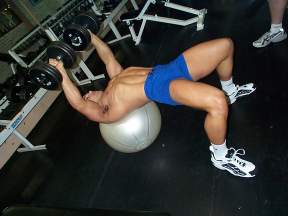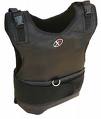It seems my functional approach has raised the shackles of some weightlifting traditionalists.
While I appreciate the value of this exercise for aesthetics, I disagree that it has any purpose other than to keep shoulder and elbow rehab specialists in business.
Agree? Disagree? See how the inspiration for this post began:
The latest comment on a bench press article “The Bench Press is a Useless Measure of your Strength pt1″ made some really good points. It also got me thinking about the things I didn’t say in my last article about the bench press.

See! Even fitness models do these exercises! Now if I could just get him to start wearing a shirt to the gym...
So when I received the comment from ‘Dokola’ taking contention with my approach, I I was encouraged since he/she also asked some really good questions and made some common statements I hear a lot with my work teaching personal trainers.
So good were these questions, that they (and my responses to them) ended up as enough information to warrant another post with a deeper explanation of a modern functional vs a traditional approach.
Dokola’s comments in italics with my comments in blue below are as follows:
IMO a power lifting total would be a better measure of strength, bench press is but one of the lifts that make up that total.
 1. It is a compound exercise that can be used to increase strength in the muscles involved. It is up to the athletes sport specific training to transfer that strength in to athletic performance.
1. It is a compound exercise that can be used to increase strength in the muscles involved. It is up to the athletes sport specific training to transfer that strength in to athletic performance.
1. “Can be used to increase strength in the muscles involved.”
No argument from me on that point. My key beef is whether that strength has any crossover to the actual sports activities. If that strength comes with coordination, then you have an athlete. This activity doesn’t really teach that.
2. The shoulders are most stable in the shoulders back and down position it is best to press from a stable position unless you are in a fitball dumbbell pressing competition (joke).
2. “The shoulders are most stable in a back and down position.”
Again, no question. But when ever again do you use them in a back and down position? If they naturally move in all positions when being used, shouldnt the exercise allow the shoulders to move somewhat freely? (kind of like when on a fitball where you are supported through the middle of the back but have at least some space to move on either side). Pretty sure your joke is right on the money, there are no fitball dumbbell pressing comps.. but how cool would that be to see?
Here is correct technique for bench press to avoid shoulder issues. http://www.youtube.com/watch?v=vUcjOIZc80c
3. Balance pressing exercises such as bench press with pulling exercises such as barbell rows, problem solved.
3.You could balance pressing exercises with pulling exercises – I totally agree. It might take more than just barbell rows to balance out the muscle and functional symmetry though. I might also argue that barbell rows might not solve the internal rotation issues that come with heavy bench pressing. Simply reversing the exercise can work in some cases, but not necessarily in this one. The exercise you are suggesting (I love barbell rows, especially when done from an unsupported position) is an excellent one, but does not necessarily address the massive flexibility issues through the chest, shoulderblades and thoracic spine.
So not quite ‘problem solved’ – but if more bench press lovers did more back work, it would certainly help, no denying that! If only they could see their backs in the mirror they might be more motivated to work them 😉
4. Get a spotter, you can use a squat rack or a training partner.
4. Not being able to proprioceptively control the weight you are handling = risk of injury. I agree, for heavier weights on a dumbbell press on fitball get a spotter or training partner – just as any heavy lift, thats what friends are for. I dont think it matters if you are on a bench or a ball for that issue. Of course, it seems to be that everytime I lose balance and need help that my spotter seems to be distracted with a new range of skimpy underwear that passes for ‘workout gear’ in gyms nowadays.
Barbell/Dumbbell Press on Fitball = Unsafe with heavy weights, progressively increasing the weight is essential for building strength.Forgive me if I don’t look on youtube to see if there is a 600lb fitball barbell press.
I wouldn’t look on youtube either for a 600 lb press on fitball. The kind of stuff we are talking about here is based on new science, which usually takes a good 5-8 years to sift down to the basement gyms that would likely post such a video.
If you are pushing 600 lbs then you are certainly stronger than most at the bench press, no denying that. I do wonder how much less you would lift when you had a ball underneath you and your core had to control and stabilize the weight. If you are benching 600lb, I would be suprised if you could push out more than 150 lbs in each hand. You certainly would want to work up to that as well, because muscles other than your chest would be worked to the max as part of that movement.
There are fitballs out there built to take the job on as well: click here to see one
The above fitball is good for up to 1200 lbs. Should be enough for even the biggest muscly fellas, right?
Chest fly on fitball/Standing one arm cable press = Isolation exercises are hardly an alternative for a compound exercise (don’t care if you do them on a fitball its still an isolation exercise).
I appreciate your perspective, and I often find the proof is in the practical. I would request you to try doing (with a decent weight) a one arm dumbbell press on a fitball and you tell me if it is an isolation exercise or not. I will be impressed if you dont feel a whole world of extra muscles (all the way down to the opposite foot of the hand that is pressing) working to stabilize you.
In fact, I think you will find a standing cable 1 arm press can work so many other muscles you might wonder if it is a chest exercise at all!
Push-ups with different hand positions = Quickly grow out of these, adding weight is difficult.
Pushups in different positions? True, they are easy to grow out of for the tough guys – tried one arm pushups with different hand positions? with a hand on a small medicine ball? with feet on a raised platform? while wearing a 60 lb weighted vest? That oughta keep you busy at least for a few workouts 🙂
I would suggest dips and overhead press as reasonable alternatives although doing bench press along with overhead press and dips would be ideal IMO.
Please remember readers (and Dokola) that I am coming from a functional standpoint and the points raised are extremely valid if aesthetics and improving my bench press for bench presses sake were the sole focus.
If that is your goal then you are right on the money to bench press your world away and all of the above is irrelevant. If you are talking function/ability on the sporting field/healthy interactive joints that stay that way for a long time… well then hopefully you will try some of the above ideas and let me know if you feel anything different working.
Thanks sincerely for your comment Dokola! Love your input and thank you for asking such great questions. I talk about things that are off the beaten track and sometimes these perspectives are not always explained as well as they could be.
By Dokola asking me the above questions I had an opportunity to further explain where I was coming from in regards to the excessive value given to the bench press exercise. Which is just part of the reason it is great to get a variety of perspectives on this since it opens up the discussion to answer different people based on perspectives they are interested in.
While I am at it, thanks to all for your comments on this forum of my thoughts and findings.. I welcome any and all perspectives on my work as long as we can promise to be friends and have a whey-free protein shake together afterwards 🙂
Jamie Atlas
https://jamieatlas.wordpress.com
Like what you see?! Become a subscriber by clicking in the top right hand corner of this blog!












































